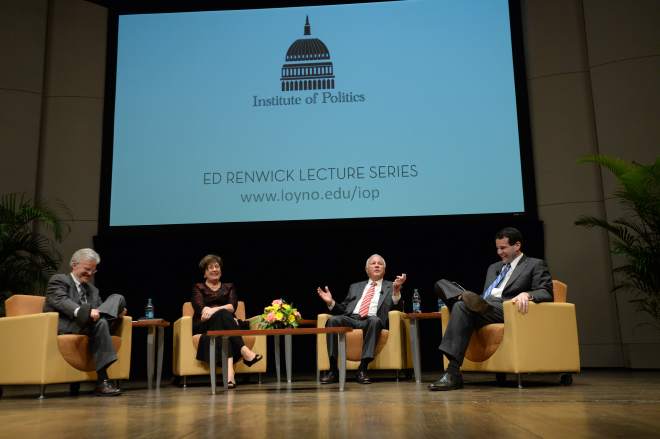http://www.theneworleansadvocate.com/opinion/8729494-171/stephanie-grace-ex-govs-agree-on
Photo by Harold Baquet, Loyola University Office of Public Affairs — From left, moderator Lee Zurik with former Govs. Buddy Roemer, Kathleen Blanco and Edwin Edwards at the Institute of Politics Ed Renwick Lecture at Loyola University in New Orleans.
BY STEPHANIE GRACE
sgrace@theadvocate.com
April 01, 2014
Proponents of the Southeast Louisiana Flood Protection Authority-East’s lawsuit against 97 oil and gas companies say that, in private, they’re not only getting a fair hearing from many politicians but sense some support for their effort to force the powerful industry to help remediate coastal damage. Ask them to name names, though, and they turn mum.
Opponents, of course, are showing no such reluctance. Gov. Bobby Jindal adamantly opposes the suit, and sympathetic legislators, led by oil and gas man and state Sen. Robert Adley, R-Benton, are seeking to kill before it ever gets to court. Jindal removed the effort’s prime architect, author John Barry, from the levee board and is maneuvering to stack it with allies, even as the Legislature is poised to consider codifying more gubernatorial control. The Louisiana Oil & Gas Association sued, arguing Attorney General Buddy Caldwell had no right to OK the suit in the first place, but a judge ruled in Caldwell’s favor. Meanwhile, LOGA President Don Briggs has been vociferously arguing that the suit would have a chilling effect on companies that do business in the state, although in a deposition, he couldn’t come up with a single example.
Such is the atmosphere surrounding the suit and the widely perceived risk in bucking one of the state’s biggest employers and most potent political forces.
That’s what made last week’s unmitigated endorsement of the lawsuit by three former Louisiana governors remarkable.
It’s not that Buddy Roemer, Kathleen Blanco and Edwin Edwards said anything particularly outlandish when they appeared at a Loyola University Institute of Politics forum. Instead, they simply acknowledged that the industry bears responsibility for environmental damage its operations caused and argued that going to court is not a form of intimidation but, rather, a perfectly acceptable way to determine liability.
“All you gotta do is fly over the coastline of Louisiana,” Roemer said. “You don’t need a big speech, you don’t need a lecture series, you don’t need to read a book. Just hitch a ride on a plane, fly over our coastline and see that we are literally disappearing,” particularly along the channels dug by oil and gas interests.
“They do what is best for capitalism, that is to maximize their profits. And the job of the regulators and the citizens is to make sure that damage done is repaired. And that should figure into the cost of profit, and it’s not done now, and Louisiana is particularly egregious in this matter,” he said. “In my opinion, this ought to be a for-profit state, but those who abuse the privilege and don’t pay for damaging the land and water and air which we breathe ought to pay the cost to fix it.”
Next up was Edwards, who noted that “the damage is there, they have made billions of dollars, they have paid millions of dollars in taxes.”
“At the very least, we ought to go to court and find out who is responsible and to what extent, and if it’s determined that they are, then they should be required to pay,” he said.
Then came Blanco, who reminded the crowd that she’d overseen the creation of the independent levee boards in the first place and is “rather concerned that it’s going to be repoliticized.”
“Well, I think that certainly both governors are correct. We’ve all known that the channels that were dug and not restored have contributed mightily to our land loss,” she said. “I would predict that these major companies will come to the table if the lawsuit isn’t destroyed in the political process by the Legislature, but I think that they’ll come to the table and we’ll have a negotiated settlement. I think that they all know that it’s long overdue and that they owe something back to the state of LouisianaŠIt may not go all the way through the court system, but it will bring everybody to the table and force a more honest discussion than we’ve ever seen before.”
Those don’t sound like fringe sentiments, and they don’t come from fringe players.
Roemer, a former Democrat, became a Republican while in office and embarked on a banking career afterward. He can hardly be labeled anti-business, even if he has embraced a crusade in recent years against the poisonous influence of special interest money in politics.
As governor, Blanco was pretty mainstream on oil and gas issues, although she did on a few occasions push back against the industry, with little blowback.
And Edwards may be a lifelong populist, but he coexisted just fine with the industry, as have most Louisiana politicians.
The other thing the three have in common, of course, is that they’re untouchable. Roemer and Blanco are safely retired from politics, and while Edwards is going for an unlikely comeback, he doesn’t seem worried about ticking off any powerful interests.
No, this was just a common-sense take from three politicians who know the lay of the land but have nothing to fear.
Makes you wonder what some of today’s politicians might say out loud, if they felt they could.
Stephanie Grace can be contacted at sgrace@theadvocate.com. Read her blog at http://blogs.theadvocate.com/gracenotes.
Special thanks to Richard Charter
